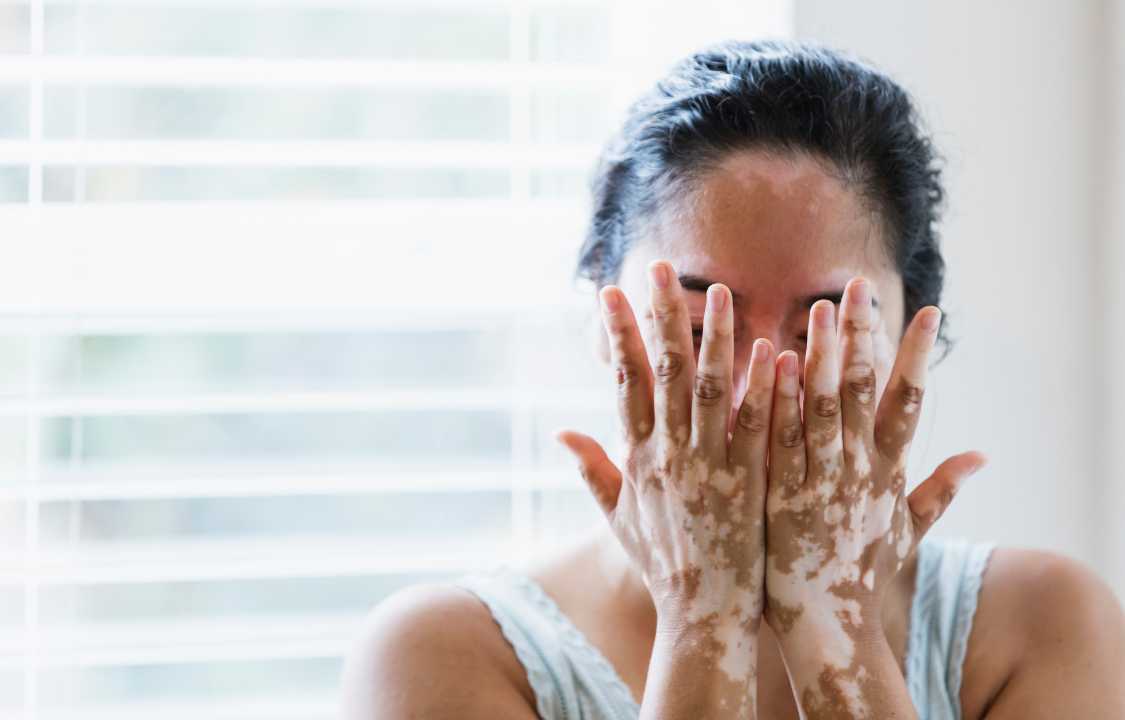Vitiligo is an autoimmune skin condition characterized by the loss of pigmentation in patches of skin, leading to areas that are either lightened or completely devoid of color. This condition arises when the body’s immune system mistakenly targets and attacks melanocytes, the skin cells responsible for producing pigment. As a result, the affected skin gradually turns milky white.
Vitiligo does not discriminate based on age or skin tone, and its onset can occur at any stage of life. Initially, individuals with vitiligo may observe small, discolored patches, which tend to expand over time as the condition progresses. Depending on the type of vitiligo and its progression, these patches can manifest in various ways:
1. Localized Vitiligo: This type involves a few discolored patches concentrated in a specific part of the body.
2. Generalized Vitiligo: Patches are scattered across multiple body parts.
3. Universal Vitiligo: An exceedingly rare form where patches become so widespread that nearly all of the skin loses its color.
4. Non-Segmental Vitiligo: The most common type, characterized by symmetrical patches on both sides of the body.
Crucially, it’s important to emphasize that vitiligo patches are not contagious. They are typically painless and feel like normal skin when touched. However, these depigmented areas can be more sensitive to sunburn. Beyond skin changes, vitiligo can also impact the hair, eyes, and ears, potentially affecting both physical and mental well-being.
Skin Symptoms of Vitiligo
Vitiligo primarily affects the skin, leading to patches of depigmentation. While these patches can emerge anywhere on the body, they often appear symmetrically on both sides, particularly in the following areas:
- Face
- Elbows
- Knees
- Backs of the Hands and Feet
- Genital Region
Initially, vitiligo patches exhibit a subtle lightening of the skin tone. Over time, they transition to a pinkish hue before becoming distinctly white. These patches usually have irregular shapes and can vary significantly in size, depending on the type of vitiligo.
The extent to which these patches spread differs from person to person. Dermatologists have identified several types of vitiligo, as mentioned earlier. Importantly, individuals with vitiligo typically do not experience pain as patches develop. However, some may notice itching as patches begin to expand, and their skin may become more susceptible to sunburn.
Hair Symptoms of Vitiligo
In addition to affecting the skin, vitiligo can also lead to changes in hair color. As the condition progresses, some individuals may notice premature graying or whitening of hair strands. While this can happen anywhere on the body where hair is present, most commonly, it affects the hair on the scalp, eyebrows, eyelashes, mustache, and beard. In cases where patches form on the limbs, individuals may also observe the whitening of arm and leg hair.
Eye Symptoms of Vitiligo
Vitiligo often involves patches appearing on the face and around the eyes. However, this condition can extend beyond the skin and affect the cells within the eyes themselves, not just the surrounding skin.
Melanocytes, which produce pigment, are found in both the skin and the eyeballs. When vitiligo progresses to affect the face and eye area, it can lead to eye-related changes. Individuals with these changes typically experience inflammation in the retina (the light-sensitive inner eye layer) and alterations in iris color (the colored tissue around the pupil). Consequently, they may notice increased eye sensitivity or shifts in iris color.
In rare and severe cases, vitiligo can even result in changes to vision. Regular visits to an eye specialist, such as an optometrist or ophthalmologist, may be recommended to monitor eye health.
Ear Symptoms of Vitiligo
Although less common, vitiligo can also impact the ears. As the condition advances, it may affect the ear canal. While melanocytes primarily contribute to skin pigmentation, they also play a role in supporting hearing in the inner ear. As a result, individuals with vitiligo may experience changes in their hearing if the condition spreads to their ears.
Statistics indicate that a substantial portion of people with vitiligo, ranging from 12% to 38%, may experience some form of hearing loss in conjunction with their skin patches.
Mental Health Symptoms of Vitiligo
While not a direct symptom of vitiligo, the condition’s impact on appearance can have significant repercussions for mental health. Many individuals with vitiligo may become self-conscious or embarrassed about their altered skin, which can lead to a decrease in self-esteem. The desire to conceal the condition may result in social withdrawal, increasing the risk of social isolation, social anxiety, depression, and other emotional challenges.
When to Seek Medical Attention
While vitiligo itself is not life-threatening and doesn’t require emergency medical attention, it can affect both physical and emotional well-being. Therefore, it’s advisable to consult a healthcare provider if you notice changes in your skin tone. Healthcare providers typically collaborate with dermatologists to conduct tests and make an accurate diagnosis.
Additionally, individuals living with vitiligo should maintain regular contact with their healthcare provider to monitor potential changes in their overall health, including vision and hearing. It’s essential to address any mental health challenges that may arise due to the condition. Support groups for vitiligo or consultations with mental health specialists can be valuable resources for individuals navigating these emotional aspects.
In Conclusion
Vitiligo is an autoimmune condition characterized by the loss of skin pigmentation due to an immune system attack on melanocytes. The resulting patches of depigmentation, which vary in size and location, primarily affect the skin but can also influence hair color, eye appearance, and hearing.
While vitiligo patches are generally painless and non-contagious, they can be emotionally challenging due to their impact on appearance. Mental health support and consultation with healthcare providers are essential components of managing vitiligo. Monitoring any changes in vision and hearing is also recommended.
Understanding the diverse symptoms and effects of vitiligo empowers individuals to take a proactive approach to their health and well-being while fostering acceptance and self-confidence in the face of this condition.

